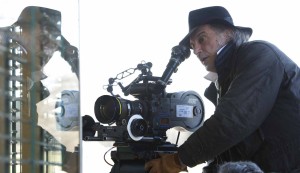
Directed by Todd Haynes who reteams with Lachman for the fourth time, Carol is the latest movie to be adapted from a novel by Patricia Highsmith. It is based on “The Price of Salt,” her second book. The novel was published under the nom de plume of Claire Morgan, perhaps because of its lesbian theme, which might alter her reputation as a writer of psychological mysteries like “Strangers On a Train”.
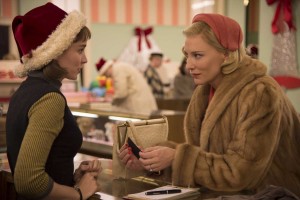
Carol follows two women of different ages from very different backgrounds who find themselves in an unexpected love affair in 1950s New York. Cate Blanchett plays Carol, the older of the two, and Rooney Mara is Therese. “I love how Todd holds back on the relationship as long as he does so we can play into these subjective amorous feelings they have for each other,” said the DP. “You rarely get to see that in contemporary cinema generally because people are jumping into bed with each other and instantly having sex.”
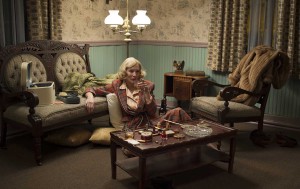 Instead of looking to duplicate the stylized movies of that period, he surveyed mid-century New York-based photojournalists who became art photographers and started experimenting with color. They included Esther Bubley, Ruth Orkin , Helen Levitt, Vivian Maier and Saul Leiter. “I looked at Ektachrome photos of those years which had a muted feeling of coolness mixed with warmth, and thought it would be good way to visualize the time between the end of World War II and the first years of the Eisenhower Administration. The country went through a big post-war retrenchment and also suffered from insecurity spawned by things like the Joe McCarthy Red scare and the Soviet Union taking over Eastern Europe. We wanted to create that feeling of uncertainty as a visual metaphor for the storytelling.”
Instead of looking to duplicate the stylized movies of that period, he surveyed mid-century New York-based photojournalists who became art photographers and started experimenting with color. They included Esther Bubley, Ruth Orkin , Helen Levitt, Vivian Maier and Saul Leiter. “I looked at Ektachrome photos of those years which had a muted feeling of coolness mixed with warmth, and thought it would be good way to visualize the time between the end of World War II and the first years of the Eisenhower Administration. The country went through a big post-war retrenchment and also suffered from insecurity spawned by things like the Joe McCarthy Red scare and the Soviet Union taking over Eastern Europe. We wanted to create that feeling of uncertainty as a visual metaphor for the storytelling.”
Lachman shot Carol in Super 16mm, a format rarely used these days for a major motion picture. “I felt It had a kind of emotional quality we discovered when we shot Mildred Pierce,” he said. “We wanted to create the sense of feeling in the grain, which you do not see in 35mm, because it looks too good these days, almost digital,” he said “Film has the anthropomorphic feeling of life, like breathing—it’s not pixel-fixated and on one plane like the digital medium. The spectrum of color negative film is different than the digital world, the colors can mix and there’s an overlap in color temperature that you can play with in film.”
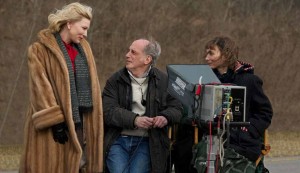 He also utilized decades-old Cooke Speed Panchro lenses that chromatically enhance an image when filming under restricted illumination. “I didn’t want to use high contrast or highly color-corrected lenses–I wanted to use glass lenses of that period,” he said. The Panchros are more like portrait lenses, he noted, “sharper in the center and then they fall off. They’re very beautiful for faces.”
He also utilized decades-old Cooke Speed Panchro lenses that chromatically enhance an image when filming under restricted illumination. “I didn’t want to use high contrast or highly color-corrected lenses–I wanted to use glass lenses of that period,” he said. The Panchros are more like portrait lenses, he noted, “sharper in the center and then they fall off. They’re very beautiful for faces.”
The beautiful faces of Blanchett and Rooney are frequently captured looking through windows. “We’re shooting them through doors and reflected through windows,” the DP noted. “By seeing these characters partially obscured we’re attempting to express their mental states and their romantic imaginations.” He likens these images to paintings by Edmund Hopper. “We the viewer are looking at the people in the Hopper paintings who are looking through a window. They are imprisoned by this transparency.” Many conversations between Carol and Therese in the film take place through car windows. One especially striking image is Therese looking through the window of a cab and it’s raining. “It’s an emotional window we’re seeing her through,” he explained.
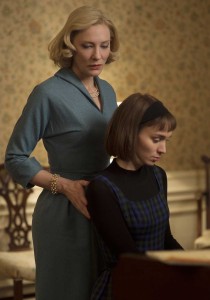 The film is the fourth in a fruitful collaboration between Lachman and director Haynes. “Todd and I have a wonderful kind of yin-yang relationship that so many great ideas and perspectives come from,” said the DP. “We discovered the language in this film which I like to call a ‘poetic realism.’”
The film is the fourth in a fruitful collaboration between Lachman and director Haynes. “Todd and I have a wonderful kind of yin-yang relationship that so many great ideas and perspectives come from,” said the DP. “We discovered the language in this film which I like to call a ‘poetic realism.’”
The two worked together for the first time on Far From Heaven in 2002. That movie also has a gay theme—of a husband hiding his homosexuality from his wife in the early 1950s. Both the cinematographer and the director received Academy Award nominations for their work, along with star Julianne Moore who got a nod for best actress. They also collaborated on I’m Not There, about musician Bob Dylan, with eight actors playing various facets of the singer-songwriter’s identity, including Blanchett. And in 2011 they worked together on Mildred Pierce, a 10-hour HBO mini-series starring Kate Winslet that got 12 Primetime Emmys; Lachman was also nominated for one.
For Carol, Lachman recently got nominated for an Independent Spirit award for best cinematography. And a few weeks ago he received the Golden Frog, the top honor at Camerimage, an annual festival held in Poland for cinematographers who gather there for a week of interchanges and handing out of prizes. Among directors of photography the awards are considered among the highest honors for the craft. Lachman, with his latest win, now has a hat trick. He won the Silver Frog for Far From Heaven and the Bronze Frog for I’m Not There. In addition, he and Haynes also received the Camerimage cinematographer-director duo award in 2011.





